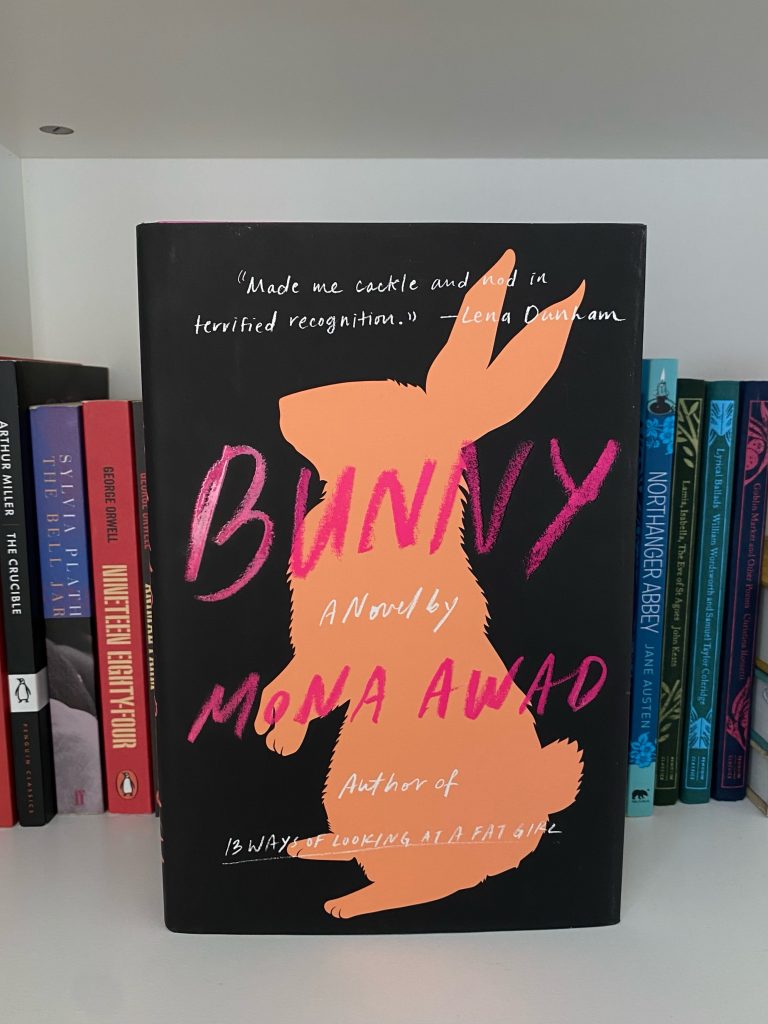Warning: Spoilers ahead!
Just like the silent, skittish animals of its namesake, Mona Awad’s Bunny creeps up on you. For the first several chapters, the story comes across as a fairly normal work of contemporary fiction, the “dark” elements of its academic setting hidden from view. Bunny follows Samantha, a writer on a fellowship at the prestigious liberal arts school “Warren,” who struggles with a major creative block. She begrudgingly attends faculty events, avoids her thesis advisor, and spends hours at the local diner complaining about the other women in her program with her only real friend, the self-assured Ava. But from the beginning, a few things feel off.

Each sickeningly sweet, hyper-feminine member of Samantha’s graduate English cohort—dubbed a “Bunny”—feels like an early 2000s mean girl cliche dropped in the middle of a mature literary fiction setting. Their adorable dresses, cooing camaraderie, and love of miniature foods are certainly not the most bizarre aspects of the environment, but there is something unusual about the intense level at which they commit to this sustained performance and the fact that all five of them present a seemingly identical personality. As details about their more sinister activities are unveiled, a classic horror juxtaposition forms between their blinding smiles and the blood trailing from under attic doors. The fact that this is a familiar cliche is not lazy writing, but clearly intentional—the stark presence of recognizable character cliches in an otherwise commonplace setting becomes a speculative feature in itself by indicating that something is not quite right. As this builds, Awad expertly rides a fine line between fantasy and reality, stoking an uneasy tension in the reader by leaving them unable to determine how exactly events are going to progress.
The Bunnies are not the only characters who fall into distinct cliches. By holding hands and wishing on exploding rabbits, the group of women can spawn counterparts of homunculi bunny-men, which they call “Darlings.” They say these men are part of their degree work: a creative endeavour, a physical exploration of the conceptual “Body” they pretentiously invoke in their workshop feedback. Most of the man-creatures are variations on a particular cliche that the Bunnies are trying to realize: the sexy Frenchman, the emotionally attentive artist, or a combination of multiple cliches, like the career-indecisive “chefarpenter.” Often the Bunnies are unsatisfied with how the Darlings turn out, complaining about small details that are off—sometimes related to their physical form, sometimes about their thematic persona. When that happens, one woman will guide the creature away from the scene to take them out, quite literally “killing their darlings.” The Bunnies playfully assure Samantha that this is just part of The Process and even refer to some of the Darlings as “first drafts.” The references to English academia are equally comedic and unsettling, and the ongoing presence of recognizable (and therefore out-of-place) cliches continues to generate tension between the real and the unreal.
For the Bunnies, conforming to the cliche is the only way to prove one’s value, something that becomes true for Samantha as she becomes more involved in their world. When her long-standing revulsion towards their ways loses against an innate desire for acceptance and sisterhood, she makes a frightening transformation and becomes a one-note, mean girl cliche herself. While Samantha is initially in disbelief over the horrifying situation she’s entered, she is quickly hypnotized and drugged into a new reality, falling into a form of simplified narration that is even more terrifying than the bloody decapitations. Her perspective loses all feeling as she becomes a Bunny, seeing herself only as part of a collective; her morose individuality is replaced by glitter and pink plastic ponies. Bunny Samantha is the ultimate horror creation, lost to cliche in yet another instance where a cliche is invoked to generate fear. For a main character who is a writer, accidentally embracing a cliche could be the most frightening outcome of all.
Ultimately, what allows these cliches to effectively function as horror elements is genre. Bunny is arguably a magical realist text. There are no rules for the mechanics of its supernatural elements, what substance makes up the “Tic Tac” pills Samantha is pressured to take, or what power source allows the rabbit-centred blood rituals to succeed. This lets the unusual details like out-of-place character cliches occupy an unidentifiable space, one that generates a terror-inducing tension. On top of it all, both Awad and her characters are exploring familiar cliches, which results in a kind of self-aware speculative horror that feels fresh.
